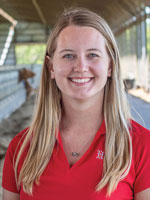
County and state fairs are some of the best chances to chat with consumers as they are walking through the barns. But when it comes time to have these conversations, whether you are the one starting the conversation or not, how do you make sure it’s a productive interaction? What if they ask a difficult or uncomfortable question?
Between many years as a dairy cattle exhibitor at my county’s fair and the Wisconsin State Fair, and my training from the Midwest Dairy Ambassador program, I’ve gained quite a bit of experience talking with consumers. Here are some tips to help you out in these situations.
1. Ask questions. Say a fairgoer asks you a question that doesn’t have a simple, quantifiable answer, such as, “Is it true that milk is filled with pus?” This is a common misconception I have often heard. As easy as it would be to simply say “no” and be done with the conversation, start by asking where they heard this information, or why they think it may be true. This will help you understand the root of their beliefs, so you can have a productive conversation about comparing reality with what they have learned.
2. Avoid only using facts. Those in the dairy industry are some of the smartest people I know. On a dairy farm you learn about complex concepts from biology to chemistry and even engineering. Look at my example question from above. It’s tempting to respond with somatic cell counts, or antibiotic withdrawal dates and processes to explain why milk is not filled with “pus.” However, these explanations can be long-winded and confusing to the average consumer. They can be great to mention in a high overview manner, but facts should not be your entire response. In general, if you start your response to a question with “Actually . . .”, you are probably just saying facts rather than telling a story.

4. Tell your story. Consumers who are far removed from agriculture don’t have any stories to tell about farming, but you do. Become that face they think about when they are shopping in the dairy aisle. Consumers are genuinely curious about where their food comes from, and it helps when there is a person or story they can connect their food to. The dairy industry is unique because there are thousands of family run businesses behind the products people see in the grocery store. Many other items people shop for only have huge corporations behind them. By telling where you come from or how you are connected to the dairy industry, you are building the bridge from consumers to producers.
Good luck this summer at the fairs, and remember to always advocate for the future of agriculture whenever you get the chance!









